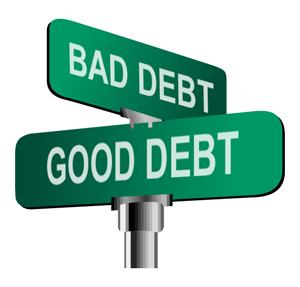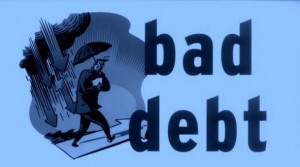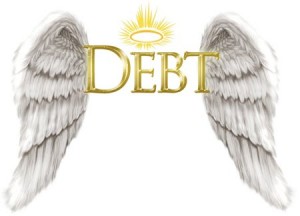What you don’t owe can’t hurt you
by Ivan Serrano
Follow Ivan @ivanserrano55
Naturally, there’s good news and bad news. Most people want the bad news first, and then the good news. Others just prefer to take the good news and never even hear about the bad news… if possible.
When it comes to debt, however, what you don’t know can hurt you. There are times when debt makes sense, and times when it should be avoided like the beach in the middle of a hurricane.
Here are some general guidelines, then we’ll take a look at both bad debt and good debt separately.
General Guidelines for Debt
First of all, let’s look at emergencies. One of the time-honored purposes building your reputation with lenders is building your capacity to deal with unexpected developments such as health-care emergencies, that insurance and savings are not sufficient to handle. At times like these, when life and limb are at stake, debt should  be considered.
be considered.
In general, if you are using your debt as an investment, and the timeframe for paying back the debt roughly coincides with the timeframe for realizing a return on the investment, you should be okay.
If, however, you are planning to use the borrowed money for purposes that can be characterized more as spending rather than investing, then stay away from it.
When evaluating debt, always look at the total amount you will be paying back, not just the amount you are borrowing.
If you have to borrow, find a lender where you will not be penalized for paying your debt back early. Avoid borrowing if there are deterrents to early payment.
Unless the interest rate on your debt is lower than the interest rate on your savings, pay your debt off as quickly as possible. Paying a little extra every time you make a payment is an excellent strategy.
Before attempting to borrow, know your credit score. This will give you a general idea, not only of how much a lending institution might allow you to borrow, but what your interest rate might be as well.
Don’t go into debt without knowing the impact of your new obligations on your current budget.
All debt brings with it some risk. There is no such thing as sure-thing investment. If it sounds too good to be true, it probably is.
Bad Debt
Credit card debt is bad debt. Pay your credit cards in full every month. If you can’t do that, pay more than the minimum, and try to avoid adding to the debt. You’ve got to stop digging deeper if you want to get out of that hole.
Avoid buying things that begin with the letter “C” using debt: cars, clothes and consumables. These are things that either lose significant value as soon as you take possession or things that have no resale value whatsoever. In particular, avoid  financing recurring services and food purchases.
financing recurring services and food purchases.
Using debt to finance purchases of goods and services that are “on sale” is a particularly pernicious practice, as the interest service on the debt will immediately erode any savings you were expecting.
New cars lose significant value as soon as you drive them off the lot. A far more rational strategy for transportation, if you must own a vehicle, is to pay cash for a used car. Even when buying a vehicle for your business, this strategy will give you more flexibility and freedom in the long run.
Speaking of vehicles, using debt to purchase recreational vehicles like campers and boats is another practice to be avoided. These items are often used very infrequently, but the interest payment rolls around every month, raising the cost per use.
In general, do not finance consumables or non-essentials.
Good Debt
Financing purchases of real property and physical assets that have clear and broadly accepted strategies for liquidating are generally considered good debts. Real estate, both commercial and residential, have historically been considered very reasonable investments.
In general, these are longer-term debts which, because of the higher value, come with lower interest rates. But don’t be fooled, by lower advertised interest rates. Taken over time, they add up dramatically. As with bad debt, it is always wise to consider the total amount you will be paying back rather than the amount you are borrowing.
Of course, taking into account the macroeconomic environment should always be a consideration when evaluating long-term debt.
Higher education has traditionally been considered a good investment as well, but crippling levels of student debt and turn a great job into soul-crushing drudgery and seem more like poverty-driven indentured servitude than launching a career after graduation.
Financing a business is another traditional good investment that is often deemed worthy of debt financing. But, even a great business plan cannot account for all the possible scenarios the marketplace can throw at your business.
* * *
Debt should always be used cautiously and as a last resort, when other alternatives have been exhausted. In fact, it can be argued that “debt free, is the way to be.” While this may be the desired state, it may not be realistic for everyone. That being the case, think twice about any new debt, good or bad, until current debts have been retired. It is impossible to get out of a hole if you keep digging it deeper.





















You must be logged in to post a comment.